
Schefflera-actonophylla
by ohcaroline
The schefflera actonophylla tree is grown in tropical and sub-tropical areas of the world. It's the parent plant to the schefflera arboricola plant which is a common houseplant.
Schefflera Tree
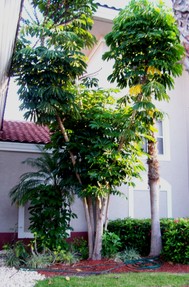 On a recent trip to the gulf coast of Florida I discovered several different trees and shrubs in the area that I had never seen before. The most outstanding tree that I saw was outside the entrance to the Hampton Inn in Venice where I stayed. I couldn't help but stop and take it in. I knew it was a member of the schefflera family; but I didn't know that they grew to be tree sized. There's also a smaller schefflera to the left of the big one. I took pictures so I could identify it when I got home. Being a self professed information geek; I wanted to learn more about it. Here's what I found.
On a recent trip to the gulf coast of Florida I discovered several different trees and shrubs in the area that I had never seen before. The most outstanding tree that I saw was outside the entrance to the Hampton Inn in Venice where I stayed. I couldn't help but stop and take it in. I knew it was a member of the schefflera family; but I didn't know that they grew to be tree sized. There's also a smaller schefflera to the left of the big one. I took pictures so I could identify it when I got home. Being a self professed information geek; I wanted to learn more about it. Here's what I found.
Schefflera Actonophylla is the botanical name.
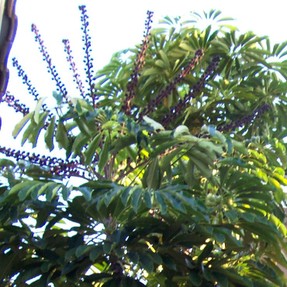
I have grown schefflera plants in the past and always liked their beautiful clusters of leaves. These houseplant versions are called schefflera arboricolas. They are the dwarf variety of
the schefflera tree which is the schefflera actonophylla. This is what I saw at the hotel. I
think most trees are beautiful...but this one really caught my eye. I'm guessing it was about
30 feet tall and had stems of red fruit at the top (you can see them in the picture). From what I
have read the birds and other small animals like to eat the fruit. They also bloom in the spring and early summer.
These trees grow worldwide.
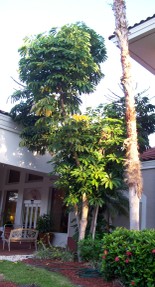 The schefflera tree is also called the umbrella tree and is very common in tropical to sub-tropical regions of the world. They are found in Hawaii, Australia and New Zealand and Brazil. I've included some links below to sites that have a wealth of information and images of the trees. It seems that this tree can become a very invasive tree; so I think you would want to plant it with care in regard to the surroundings. Caring for scheffleras seems to be pretty easy. They do like a fairly sunny growing spot. These trees are very hardy in that if they get nipped by frost; they will grow back in time. They don't require much care other than cleaning up the dropped fruit. Be careful not to overwater. I can personally attest to killing some of the houseplant variety of scheffliera by watering too much. Any type of general fertilizer works well with this plant. Nevertheless, I think I would like to start a couple of trees from seed. I probably will grow them in large pots to put on the patio and then prune them to keep them a good size. If I do...I'll write an article to chronicle my success with it.
The schefflera tree is also called the umbrella tree and is very common in tropical to sub-tropical regions of the world. They are found in Hawaii, Australia and New Zealand and Brazil. I've included some links below to sites that have a wealth of information and images of the trees. It seems that this tree can become a very invasive tree; so I think you would want to plant it with care in regard to the surroundings. Caring for scheffleras seems to be pretty easy. They do like a fairly sunny growing spot. These trees are very hardy in that if they get nipped by frost; they will grow back in time. They don't require much care other than cleaning up the dropped fruit. Be careful not to overwater. I can personally attest to killing some of the houseplant variety of scheffliera by watering too much. Any type of general fertilizer works well with this plant. Nevertheless, I think I would like to start a couple of trees from seed. I probably will grow them in large pots to put on the patio and then prune them to keep them a good size. If I do...I'll write an article to chronicle my success with it.
Do these trees grow in your neck of the woods?
Tree Books for Every Gardner:
 | What Tree Is That?: A Guide to the More Common Trees Found in North America (Mom's Choice ... The Arbor Day Foundation's What Tree Is That? is a unique field guide that uses a step-by-step approach to identify common trees of the United States and Canada. The fully ... |
 | National Wildlife Federation Field Guide to Trees of North America From the National Wildlife Federation® comes the most up-to-date, all-photographic field guide to North American trees. The Jeffrey Pine, Coconut Palm, Staghorn Sumac, and ... |
 | Pruning Made Easy: A Gardener's Visual Guide to When and How to Prune Everything, from Flowers ... The author of Secrets of Plant Propagation returns with this revised edition of his book Pruning Simplified. This edition contains more than 300 step-by-step illustrations. |
 | The Illustrated Encyclopedia of Wild Flowers & Trees of North America: An expert reference and ... This title provides an identification guide to some of the most prominent plants of North America. |
Here are some links to sites that feature the schefflera tree:
http://www.hear.org/starr/images/species/?q=schefflera+ac...
Very nice group of schefflera tree images from around the world.
http://davesgarden.com/guides/pf/go/37035/
Very informative site with images as well as gardening information on these trees.
You might also like
A Tree Sacred and DeadlyAncient people's regarded yew trees as magical or sacred, but they often used...
The British OakOak trees are inextricably linked with Britishness, for if there is a nationa...
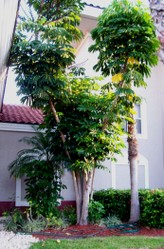



 Lake Griffin State Park Floridaon 07/29/2011
Lake Griffin State Park Floridaon 07/29/2011
 Get your passport to Florida State Parkson 07/19/2011
Get your passport to Florida State Parkson 07/19/2011
 Flat Stanley comes to visit!on 07/05/2011
Flat Stanley comes to visit!on 07/05/2011
 Tanzanite Gemstones | Tanzanite Jewelry | Tanzaniteon 06/29/2011
Tanzanite Gemstones | Tanzanite Jewelry | Tanzaniteon 06/29/2011

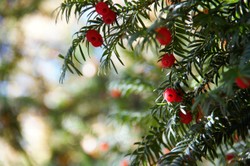
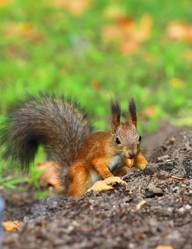
Thank you for signing my guestbook and giving it a thumbs up if you like it. You don't have to be a member of Wizzley to make a comment.
I have not seen the outdoor one before. These are interesting looking trees.
I have grown only the house plant variety but seeing this tree here, I will certainly look for it.
I had the houseplant variety years ago, I loved it. I moved and left it to my Mom, she has an amazing green thumb. Its still going, grows slow but it is a beautiful plant. Makes me want one again. Indoors as I live in Ohio
I've grown them as houseplants. I guess California is too dry to grow them outside.
Interesting.I love gardening but this one is new on me
I don't think I've even seen the houseplant variety, but maybe I'll notice one now.
From what I have read...they are some grown in Alabama. Give it a try...I'd be interested to know. Ebay has seeds you can buy for a couple of dollars; but I couldn't figure out how to get the module to pull up that particular product.
Beautiful tree indeed! wonder if we can grow these in SC? I am sure going to try!
I'm familiar with the houseplant variety, living in the northern part of the U.S. I'd love to see the tree version! Part of the awe in visiting Florida is seeing plants growing wild outside that can only grow as houseplants where I live.
we lived on the Gulf Coast a long while and I was as stunned as you to see the plants I grew inside as big as this!
good article!